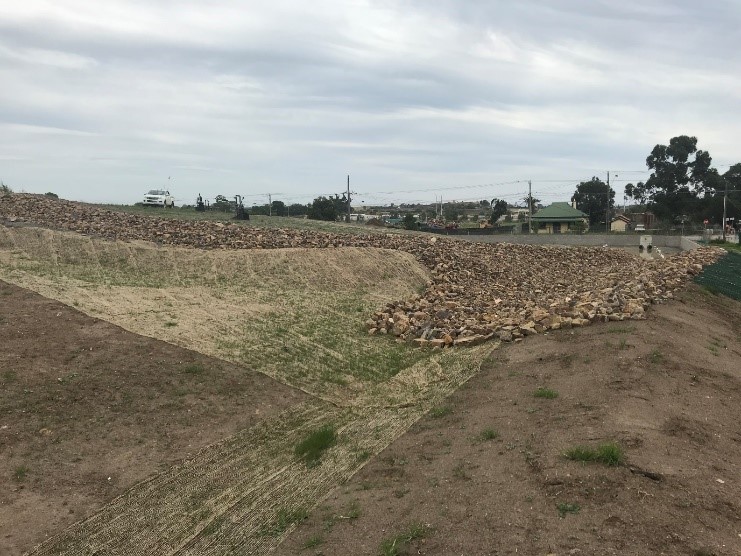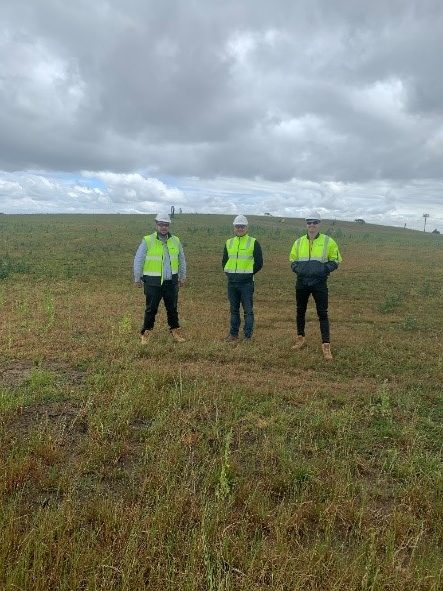During the 18-month construction process, we excavated, moved, and placed over 200,000m3 of soil, installed more than 450,000m2 geosynthetics and constructed approximately 1.5kms of anchor trenches and 2.7kms of drainage swales.
During the 18-month construction process, we excavated, moved, and placed over 200,000m3 of soil, installed more than 450,000m2 geosynthetics and constructed approximately 1.5kms of anchor trenches and 2.7kms of drainage swales.
Landfills are a necessary but least preferred option for waste that cannot be avoided, reused or recycled. Modern landfills are safe, controlled spaces – highly engineered to accept waste while protecting the surrounding environment. Once a landfill has reached capacity, it’s rehabilitated and returned for use to the community as spaces such as parks and community grounds.
Deals Road Landfill operated from the mid-1980’s until its closure in mid-2016. Cleanaway managed the rehabilitation and post closure works at the site, which involved extensive planning, modelling and design. Our main objective was to ensure structural stability, preparing the landfill to be closed and successfully revegetating the land.
We engineered and installed a geosynthetic cap covering an area of approximately 15 hectares according to Environmental Protection Authority’s (EPA) Best Practice Environmental and Management (BPEM) requirements. The cap is made up of layers of manufactured materials acting in composite to create a barrier against stormwater ingress and landfill gas egress. The cap ensures surface water is captured and managed, while remaining separate from underlying waste.
Surface water was managed through a network of drains, soil bunds and rock and grass swales which directed water to an onsite attenuation basin and eventually discharged into the local stormwater network. The basin’s design provides for extra capacity to avoid potential overflow during storms.

Pictured: Rock and grass stormwater swale to basin
The works at Deals Road created a landform surface which allowed us to seed a range of native plant species specifically chosen to support the function of the entire site capping system.
With the completion of rehabilitation works, Cleanaway will continue to monitor and maintain the site into the future.
Key project milestones
During the 18-month construction process, we excavated, moved, and placed over 200,000m3 of soil, installed more than 450,000m2 geosynthetics and constructed approximately 1.5kms of anchor trenches and 2.7kms of drainage swales. By the time the project was completed, we had:
- cut and fill soils to achieve final contours, which are the final surface shape or height of the land
- placed subgrade and general soil layers over landfilled areas of the site
- installed geosynthetics on top of the subgrade to provide containment
- constructed stormwater systems including stormwater drains and an attenuation basin
- seeded a range of native plant species to revegetate the site
- managed the collection of leachate
- captured landfill gas to be turned into energy

Pictured from left: Leo Oldridge, Barry Griffin, Dylan van Unen
Cleanaway’s engineering project team
- Barry Griffin – Head of Engineering
- Leo Oldridge – Remediation Manager / Project Director
- Dylan van Unen – Project Manager
- Srikar Rapole – Remediation Engineer
- Peter Fennelly – Post Closure Technical Lead
- Shamrock Civil Engineering (Contractor)
- Fabtech (Geosynthetic Installer)
- Senversa (EPA Appointed Environmental Auditor)
- Senversa (Geotechnical Inspection and Testing Authority)
- Tonkin + Taylor (Designer)